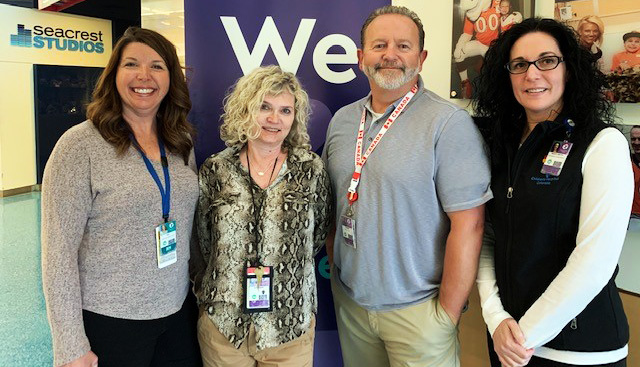Making MRIs Safer for Our Youngest Patients
Protecting and nurturing a culture of safety
Clinical Affairs | CU School of Medicine Mar 19, 2020
l-r, Jill Chuita, Katherine Bushur, Darwin Roth, Beth English
If you will be anywhere near an MRI machine, you would do well to remember two things. First, the MRI is a very large and strong magnet. Second, it’s always on.
These two facts mean that any metal object in the vicinity of the MRI has the potential to become a fast-moving projectile that can destroy anything in its path to the magnet. Though most people who work near the MRI are aware of this potential, mistakes still happen and risks are introduced. Though accidents are relatively rare, they can result in a devastating injury or death.
“Across the U.S., patients have been severely harmed by metal objects in the MRI environment,“ said Patrick Guffey, MD, MHA, Chief Medical Information Officer & Performance Improvement and Informatics Officer at Children’s Hospital Colorado. “This work is not easy, but it’s incredibly important. It’s ongoing and requires constant vigilance to protect and nurture our culture of safety.”
For Jerrod Milton, Senior Vice President of Professional & Support Services at CHCO, “relatively rare” wasn’t good enough. He and his colleagues wanted an MRI service that resulted in zero mistakes with ferromagnetic metal items.
Typical Approaches to Keeping Metal Away from the MRI
Metal objects are abundant in a hospital, but none of these should enter Zone IV where the MRI machine is located. In Zone IV, these objects can be catapulted across the room and cause serious patient harm. A pair of scissors becomes a flying spear. The metallic oxygen tank or IV pole becomes a battering ram, and a patient bed becomes an oncoming train.
Hospitals take standard measures to prevent metal objects from entering this danger zone. At CHCO, they had even installed a sophisticated ferromagnetic screener. Despite these measures, ferromagnetic metal objects would still sometimes get into Zone IV. How was this happening, and why?
How Mistakes Happen and Metal Objects Get In
While CHCO had excellent safety standards, Milton believed the organization could do even better, but it would take more than staff training.
“Training is the least reliable part of process improvement,” said Milton. “We are perfectly and inescapably human and we all make mistakes. If it can happen it will, and this situation is too potentially dangerous to let it happen even once.”
Milton brought together patient safety experts, MRI technicians, radiology clinicians, anesthesiology clinicians and others. The team used Lean Six Sigma methods to find out what was setting everyone up for failure. It turned out that the biggest culprit was the thing that was meant to keep them safer: the ferromagnetic metal screener.
The problem was not that the screener wasn’t sensitive enough, but that it was so sensitive it was setting off alarms for objects that didn’t pose a risk. The result? Alarm fatigue. In essence, the machine was training staff to ignore the alarm – and the presence of a potentially dangerous metal object.
Processes, Machines and People Make MRIs Safer
With this deeper understanding, the team created a multipronged solution focused on reducing alarm fatigue, so the screener’s alarm would be heeded every time it sounded. The challenge was to improve the reliability of the alarm without compromising the sensitivity required to alert the staff.
To do this, the team worked with the vendor to calibrate the detector. They also did an assessment to understand what was setting off the alarm and worked extensively with staff to bar those items from Zone IV – even if the item presented minimal risk. Of the interventions they put into place, the one involving a new dress code for staff working in the MRI was the hardest because clothing is personal. The list of unsafe clothing included not zippers or metal fasteners, but common items like clogs with metal rivets, underwire bras and glasses with metal. It was a true culture change that required the cooperation of staff at all levels.
“Standard procedures, environmental cues and collaborative teamwork are essential for improving patient safety,” said Daniel Hyman, MD, Chief Medical and Patient Safety Officer at CHCO. “But none of it is possible without the commitment of everyone involved in patient care to make safety a priority.”
Results: An Exemplar of MRI Safety
The reward was worth the effort. During the first year that the new processes were put into place, the team far surpassed their goal. This, among other things, prompted nationally known MRI safety expert Tobias Gilk to declare CHCO “the safest MRI provider” in a tweet from the Radiological Society of North America in December 2019.
“The team made the difference,” said Skip Grieser, a CHCO board member and part of the MRI safety team. “Everyone was a leader, from the physicians to safety experts to the frontline nurses and techs. It made culture change possible.”
In addition to Jerrod Milton, Dr. Patrick Guffey and Skip Grieser, members of the team included Kati Bushur, MRI Advanced Modality Supervisor at CHCO; Jill Chuita, RN, Radiology Nurse at CHCO; Beth English, MBB, Performance Improvement Lead at CHCO; and Darwin Roth, Patient Safety Specialist and Safety Coach Program Lead of Quality and Patient Safety at CHCO.
The team remains vigilant about MRI safety. “Patient safety is never over,” said Grieser, a former air traffic controller. “In a complex environment like healthcare, you can’t predict everything and you don’t know what the next obstacle will be. But with the right people and processes, you have a much better chance of seeing it before it becomes a threat.”